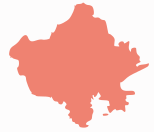|
Bharatpur district
Bharatpur District is a district in Rajasthan state in western India. The city of Bharatpur is the District Headquarters, Division Headquarters and Headquarters of Bharatpur HistoryHistorical eventsBharatpur is a place of mythological importance. In common belief, the Pandavas had spent their 13th year of exile at this place around 3,500 years ago.[4] In early medieval times, the Bharatpur region was ruled under the Mewat State under the Khanzadas of Mewat from 1372 to 1527 AD. The area in later medieval times was ruled by the Sinsinwar clan of the Hindu Jats. In 1733 AD, Maharajah Suraj Mal built the city of Bharatpur. It is believed that it was a well-fortified city under his rule. Bharatpur was carved out from the Mewat region and got its name from Lord Bharat (Lord Rama's brother).[5] GeographyBharatpur, also known as ‘Eastern Gate of Rajasthan’, is located in the Braj region 180 km away from Delhi. Geographically, the district is situated between 26° 22' and 27° 83' N and 76° 53' and 78° 17' E and its average height above sea level is around 183 m. Bharatpur city is the district headquarters and is also known by the name of Lohagarh. It is situated very close to the main cities of Rajasthan and other states. Distance between Jaipur and Bharatpur is around 178 km whereas Agra lies at a distance of 55 km from the district. Mathura is located at a distance of 34 km. Bharatpur touches Deeg district of Rajasthan in the north, Mathura in the east, Agra of Uttar Pradesh and Dholpur of Rajasthan in the south and Dausa and Alwar in the west.[6] There are only three main seasonal rivers in this District, namely Ban Ganga, Rooparel and Gambhir. Ban Ganga starts from Ramgarh Dam of Jaipur district, passes from Bharatpur and meets in river Gambhir near tehsil Bayana of District Bharatpur. Gambhir river starts from Panchna Dam of district Karauli and after passing from Bharatpur meets River Yamuna in Uttar Pradesh. Rooparel River starts from hills of district Alwar and enters into Bharatpur from tehsil Kaman. Instead of this, a Dam, namely, Bandh Baretha, is situated near the village Baretha on river Kakund, which starts from the hills of district Karauli. The water of this dam is used for drinking and irrigation purpose for this district. The capacity of this dam is 684.00 million cubic feet (29 Gaze feet).[7] DivisionsBharatpur District has many revenue subdivisions and tehsils. They have the same names and borders, except that Weir Subdivision is divided into Weir and Bhusawar. The other ten tehsils are: Bayana, Bharatpur, Nadbai, Uchchain and Roopwas (Rupbas).[8]
Demographics
In the 2011 census, the Bharatpur District had a population of 2,548,462,[3] roughly equal to the nation of Kuwait[10] or the US state of Nevada.[11] This gave it a ranking of 166th among districts of India (out of a total of 640).[3] The district had a population density of 503 inhabitants per square kilometre (1,300/sq mi).[3] Its population growth rate over the decade 2001-2011 was 21.32%.[3] Bharatpur had a sex ratio of 877 females for every 1000 males,[3] and a literacy rate of 71.16%.[3] After the separation of Deeg district, the residual Bharatpur district has a population of 1,475,707. The district has a sex ratio of 869 females per 1000 males. 362,948 (24.59%) lived in urban areas. Scheduled Castes and Scheduled Tribes made up 394,106 (26.71%) and 43,421 (2.94%) of the population respectively.[3] LanguagesAt the time of the 2011 census, 71.45% of the population in the residual district spoke Hindi and 27.64% Braj as their first language.[13] Most speakers of Braj dialect record their language generically as Hindi in the census. Trade and commerceIndustrial areasBharatpur District has been divided in six industrial areas:[14]
Oil industriesBharatpur district is known not only for agriculture production but also known for oil industries. Mustard seeds and other agriculture products come to the market through mandies established by Krishi Upaj Mandi Samiti and transported all over the country. These Krishi Upaj Mandies are in Bharatpur, Nadbai, Weir, Bayana, Roopwas and Bhusawar. There are total 554 oil mills registered in which 2317 persons are employed and Rs. 2690.84 lacs was invested. Out of these mills 78 are big units having AGMARK and rest are small oil expeller units.[14] OtherIn some areas of Bharatpur District like- Hindaun & Karauli etc. stone quarrying is also practised. Many of nearby State's Forts like The Red Fort of Delhi, Agra Fort, and Fatehpur Sikari were built using local stone.[15] Notable people
TransportThe nearest airport is situated at Agra, which is 56-km from Bharatpur. Delhi is 184 Km from Bharatpur. Regular rail services connect Bharatpur with all the major cities such as Delhi, Mumbai, Jaipur and Agra. The Bharatpur railway station is about 5 Km from the park/bird sanctuary.[16][17] References
External linksWikimedia Commons has media related to Bharatpur district.
|
|||||||||||||||||||||||||||||||||||||||||||||||||||||||||||||||||||||||||||||||||||||||||||||||||||||||||||||||||||||||||||||||||






